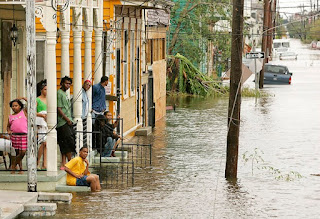In the early morning hours of today's date, August 29, in 2005 Hurricane Katrina entered the Gulf Coast of the United States. When it slammed into the city of New Orleans the storm had a Category 3 rating – it brought sustained winds of 100–140 miles per hour. The storm reached some 400 miles across. Levee breaches brought about massive flooding in the city of New Orleans herself, and hundreds of thousands of people across three states, Alabama, Louisiana and Mississippi were displaced from their flooded homes. It is estimated that Katrina caused approximately $131 billion in damage, and the death toll came to 1,833 people.
New Orleans is Slammed
New Orleans was hit particularly badly. Over time, the Army Corps of Engineers had built a system of levees and seawalls to shield the city from flooding in just such emergencies. But most of these levees failed. About half of New Orleans lies above sea level, but its average elevation is in fact roughly six feet below sea level. And of course the city is effectively surrounded by water. Thus, entire neighborhoods, many of
them containing the city's poorest residents were hit very badly by flooding and were effectively wiped out. Storm survivor Alice Jackson recalls the 29th:
"At 1 a.m., wind started pummeling the house. I woke everyone up and we listened to the radio. We learned that all three of the emergency operation centers were washed away. That's when I knew we were in big trouble. Then we lost the radio.
"All night I'd been watching a giant pine tree in a neighbor's yard. It had been bending mightily, but had stayed rooted. Suddenly I heard a deafening crack, and I yelled, "Run!" Seconds later the tree smashed through the house. We had escaped to the master bedroom closet in the center of the house. My sister-in-law hauled a mattress off the bed and leaned it on top of my mother and my niece. Then we noticed that the walls were heaving, so we raced around the house, opening windows to relieve the pressure build-up.
"Looking outside, we watched in horror as the house behind us turned into what looked like a living, breathing monster. The roof would lift, the house would expand, and then the roof would fall. Finally, the house exploded."
Katrina Flooding Brings Heroism
It had already been pouring rain upon New Orleans for some hours by the morning of this day of Aug. 29. The city's levees and most of it's drainage canals were completely overtaken by storm surges which reached as high as 9 meters. Low-lying areas suffered from water seeping through the levees left neighborhoods such as the Ninth Ward, and St. Bernard Parish under so much flooding that residents had to flee onto their roofs and attics, just to avoid drowning. In such situations as his, there was a great deal of heroism and personal sacrifice. In efforts that bring to mind the rescue of the British Army at Dunkirk in 1940, people just got into their own boats, or commandeered whatever craft they could find and began rescuing those who were stranded on their rooftops. And the U.S. Coast Guard
remained true to their calling, rescuing 34,000 people in the stricken city. Coast Guard rescue swimmer Jonathan Rice recalls:
"I did a rescue to a two-story building, where this lady threw her infant child at me, and I had to catch the child in the air," Rice said. "I'm sitting here, and I'm holding this child by the arm, and I'm going 'man, what if I would have missed this child's arm?' And she's crying and I pull her up, and I hug her real tight, and I get her inside the aircraft, and she starts smiling at me, and just reaches over and hugs me. She knew that I'd just saved her life."
The Aftermath
As a result of the winds and flooding of Hurricane Katrina some 80 percent of the city of New Orleans wound up being under water to some degree. And what made it worse was that the governmental agencies involved seemed quite unprepared to deal with the disaster. New Orleans Mayor Ray Nagin waited until the last minute before declaring a mandatory evacuation of the city. This left many people stranded, and he roads choked with outgoing traffic. Louisiana Governor Kathleen Blanco was reluctant to authorize the Federal Government to take charge of the relief effort. A large number of people who were unable to evacuate were directed to the New Orleans
Super- dome. But the resources of that facility were quickly over- whelmed, leaving people without adequate food or water. And FEMA, (the Federal Emergency
Super- dome. But the resources of that facility were quickly over- whelmed, leaving people without adequate food or water. And FEMA, (the Federal Emergency
Management Agency) took days to set up operations in the city, and even when they did, they didn't seem to have a proper plan of action. It is not my purpose here to go through all of the many mistakes that left people stranded and dying as a result of bad government. I simply haven't the space. But President George W. Bush wound up looking as if he didn't understand what people were suffering on the ground. To many, he didn't seem to care. As he wrote later in his autobiography "Decision Points":
"Just as Katrina was more than a hurricane, its impact was more than physical destruction. It eroded citizens' trust in their government. It exacerbated divisions in our society and politics. And it cast a cloud over my second term."
Sources =
http://www.history.com/topics/hurricane-katrina
http://www.people.com/people/article/0,,1102841,00.html
http://www.wwltv.com/story/news/local/katrina/2015/07/20/coast-guard-heroes-remember-rescues-after-katrina/30442355/
http://www.history.com/topics/hurricane-katrina
http://www.people.com/people/article/0,,1102841,00.html
http://www.wwltv.com/story/news/local/katrina/2015/07/20/coast-guard-heroes-remember-rescues-after-katrina/30442355/
"Decision Points" by George W. Bush, Crown Publishing Group, New York, 2010




